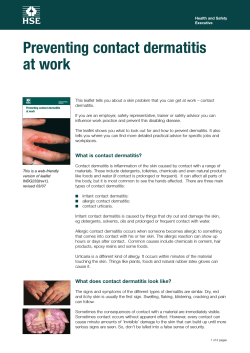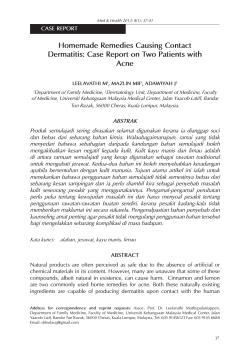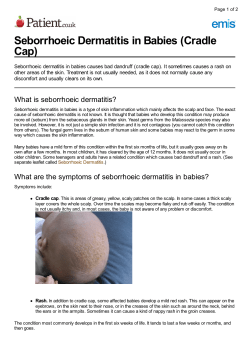
Atopic Dermatitis, Eczema
Atopic Dermatitis, Eczema Diagnosis/Condition: Discipline: ICD-9 Codes: ICD-10 Codes: Origination Date: Review/Revised Date: Next Review Date: Due to food ingestion/sensitivity Due to food in contact with skin Due to drugs and medicines applied to skin ND 691.8, 693.1, 692.5, 692.3 2/2000 11/2007, 01/2008, 05/2010 05/2012 Eczema is a general term for many types of dermatitis. Atopic dermatitis is the most common of the many types of eczema, especially in the pediatric population. "Atopic" refers to diseases that are hereditary, tend to run in families, and often occur together. Atopic dermatitis (AD) is a pruritic disease of unknown origin that usually starts in early infancy and is typified by pruritus, eczematous lesions, xerosis (dry skin), and lichenification on the skin (thickening of the skin and increase in skin markings) which is distributed in age-specific patterns. i, ii AD is associated with other atopic diseases (e.g., asthma, allergic rhinitis, urticaria, acute allergic reactions to foods, increased immunoglobulin E [IgE] production) in many patients. iii Those with AD are at an increased risk of developing a latex allergy. iv The prevalence rate in the US is 10-20% in children and up to 3% in adults. v, vi, vii The incidence of AD appears to be increasing. viii, ix, x Affected individuals must cope with a significant psychosocial burden, in addition to dealing with the medical aspects of the disease. Because this is primarily a disease of childhood, family members, especially parents, are also affected by the condition. Individuals and family members are burdened with time-consuming treatment regimens for the disease, as well as dietary and household changes. AD has been associated with parental sleep disturbances, anxiety levels, and increased maternal depression.x The cost to society is significant, with estimates ranging from less than $100 to more than $2000 per patient per year. It is estimated that the direct cost of atopic dermatitis in the United States alone is almost $1 billion per year. Health care provider visits for contact dermatitis and other eczemas are over 7 million per year. xi,x Subjective Findings and History • • • • • Acute or chronic skin inflammation with excessive pruritis (excoriations and crusting may develop) Often characterized by periods of acute flare up and remission Episodes generally more severe in first five years of life (early age of onset) Intermittent acute “wet” inflamed eruptions and chronic dry itching eruptions Etiologic factors: heredity, other atopic conditions: asthma, otitis media, allergic rhinitis in first degree relative Differential Diagnoses • • • Scabies Allergic contact dermatitis Lichen simplex chronicus The CHP Group Atopic Dermatitis Clinical Pathway 1 • • • • • • • • • • Mycosis fungoides Nummular dermatitis Relative zinc deficiency Tinea corporis Seborrheic dermatitis (SD) Mollusca contagiosa with dermatitis Cutaneous lymphoma Ichthyosis, psoriasis Immunodeficiency Other primary disease entities Objective Findings • • • • Labs • • • • • • • • Inflamed, irritated wet lesions, commonly on flexor surfaces, hands, neck, arms, legs and torso Lichenification and flexural involvement, xerosis, erythema, deposition of amyloid Common around the mouth and anus in infants Chronic appearance more commonly dry, lichenified, cracked and inflamed Appearance can be anywhere in adults, but is most common on the hands No chemical marker for the diagnosis of atopic dermatitis is known, but testing to rule out other immunodeficiencies may be helpful Biopsy shows an acute, subacute, or chronic dermatitis, but no specific findings are demonstrated Peripheral blood for elevated eosinophils, basophilia Swab of infected skin may help with the isolation of a specific organism and antibiotic sensitivity. Possible allergy and sensitivity testing often indicates triggers such as food and environmental agents Elevated IgE and decreased IgA common A platelet count for thrombocytopenia helps exclude Wiskott-Aldrich syndrome Scraping to exclude tinea corporis may be helpful Assessment • • • Laboratory tests if indicated (as above) Physical exam (pulmonary, EENT, cardiac, GI) Identification of the triggers through testing, or avoidance and reintroduction Plan Treatment goals • Identification and avoidance of triggers • Reduction of pruritis and discomfort • Prevention of secondary infection • Develop proper skin care habits, bathing and lubricants/emollients to seal in moisture and allow water to be absorbed through the stratum corneum The CHP Group Atopic Dermatitis Clinical Pathway 2 Natural Medicine • Rotation diets, avoidance dietsxii, vegetarian diet xiii; assess overall diet with elimination and challenge and/or food sensitivity testing. • Exclusion of cow’s milk and eggs xiv,xv • Maternal dietary exclusions in pregnancy and lactation xvi,xvii • Anti-inflammatory nutritional supplements and nutritional support for the GI tract; antihistamine effects anti-oxidant effects • Probiotics xviii,xix,xx,xxi,xxii • Botanicals: anti-inflammatory, liver support, GI support, anti-infective, skin tonics, antihistamine and anti-allergic herbs • Mahonia aquifolium ointment xxiii, oral Konjac ceramide xxiv, topical St John’s Wort xxv, topical Persimmon leaf.xxvi, xxvii • Topical and oral γ-linolenic acid (GLA)xxviii, evening primrose (EPO) xxix and borage oil have mixed results. xxx,xxxi, xxxii, xxxiii, xxxiv,xxxv, xxxvi, xxxvii, xxxviii, xxxix. Therapeutic doses of EPO were 500 g/day for 8 weeks xl • Constitutional homeopathic prescription Physical Therapy • Hydrotherapy. Avoid hot baths. Lukewarm baths followed by the application of a moisturizer to avoid moisture evaporation. Baths can be taken with added oils. • Local topical poultices to decrease irritation • Castor oil packs • Phototherapy (ultraviolet light (ultraviolet B, narrow-band ultraviolet B, and highintensity ultraviolet A) xli. Avoid long-term use. Relaxation Techniques and Behavioral Modification • Improved skin hygiene • Autogenic training xlii • Hypnotherapy xliii • Behavioral therapyxli • Parental training xliv • Allergen and dust mite avoidancexli • Clothing should be soft next to the skin (e.g. cotton) and washed in a mild detergent with no bleach or fabric softener. • Cool temperatures to reduce sweating which can exacerbate irritation and itch. A humidifier (cool mist) prevents excess skin drying. Pharmaceuticals • Topical corticosteroids • Emollient adjunct, xlv wet wrap dressing adjunct xlvi • Topical calcineurin inhibitors (for patients over 2 y.o.) • Topical antibiotic treatment if secondary infection Traditional Chinese Medicine (TCM) • Botanicals and Chinese herbs xlvii (Potentilla chinensis, Tribulus terrestris, Rehmannia glutinosa, Lophatherum gracile, Clematis armandii, Ledebouriella saseloides, Dictamnus dasycarpus, Paeonia lactiflora, Schizonepeta tenuifolia, and Glycyrrhiza glabrae.) xlviii, xlix, l The CHP Group Atopic Dermatitis Clinical Pathway 3 • Radix angelicae pubescentis combined with UV-A radiation li, lii Length of Treatment • Up to 4 weeks to achieve sustained improvement and longer for chronic cases Criteria for Referral or Re-evaluation • • • Ongoing acute symptoms without resolution after 4 weeks Secondary infection not responding to treatment Chronic - failure to resolve or repeated acute outbreaks over a period of several months Provider Resources Williams H. Atopic Dermatitis. N Engl J Med 2005;352:2314-24. http://content.nejm.org/cgi/content/full/352/22/2314 Hanifin JM, et.al. Guidelines of care for atopic dermatitis. J Am Acad Dermatol 2004 Mar;50(3):391-404. http://www.guideline.gov/summary/summary.aspx?ss=15&doc_id=4361&nbr=3286 Krafchik, BR. Atopic Dermatitis. 2010.,http://emedicine.medscape.com/article/1049085-print Guidelines of care for atopic dermatitis. American Academy of Dermatology - Medical Specialty Society. 2004 Mar. Patient Resources: MedicineNet.com is an online, healthcare media publishing company. It provides easy-to-read, in-depth, authoritative medical information for consumers via its robust, user-friendly, interactive web site. Atopic Dermatitis. http://www.medicinenet.com/atopic_dermatitis/page7.htm The American Academy of Dermatology. Eczema/Atopic Dermatitis. http://www.aad.org/public/publications/pamphlets/skin_eczema.html The National Eczema Association. http://www.nationaleczema.org/ The National Institute of Arthritis and Musculoskeletal and Skin Diseases (NIAMS). Atopic Dermatitis. 2009. http://www.niams.nih.gov/Health_Info/Atopic_Dermatitis/default.asp Created by The Nemours Foundation's Center for Children's Health Media, the award-winning Kids Health provides families with accurate, up-to-date, and jargon-free health information they can use. http://www.kidshealth.org/parent/infections/skin/eczema_atopic_dermatitis.html Clinical Pathway Feedback CHP desires to keep our clinical pathways customarily updated. If you wish to provide additional input, please use the e-mail address listed below and identify which clinical pathway you are referencing. Thank you for taking the time to give us your comments. Chuck Simpson, DC, CHP Medical Director: csimpson@chpgroup.com The CHP Group Atopic Dermatitis Clinical Pathway 4 i Hanifin JM, Rajka G. Diagnostic features of atopic dermatitis. Acta Derm Venereol. 1980;92:44–47. Eichenfield LF, Hanifin JM, Luger TA, Stevens SR, Pride HB. Consensus conference on pediatric atopic dermatitis. J Am Acad Dermatol. 2003;49:1088–1095. iii Eichenfield LF, Hanifin JM, Beck LA, et al. Atopic dermatitis and asthma: parallels in the evolution of treatment. Pediatrics.2003;111:608–616. iv Poley GE and Slater JE. "Latex allergy." Journal of Allergy and Clinical Immunology. 2000;105 (6):1054-62. v Rudikoff D and Lebwohl M. "Atopic dermatitis." Lancet 351(9117): 1715-21. 1998 vi Larsen F and Hanikin J. "Epidemiology of Atopic Dermatitis." Immunology and Allergy Clinics of North America. 2002; 22:1-25. vii The International Study of Asthma and Allergies in Childhood (ISAAC) Steering Committee. "Worldwide variation in prevalence of symptoms of asthma, allergic rhinoconjunctivitis, and atopic eczema: ISAAC." Lancet. 1998; 351:1225-32. viii Disease management of atopic dermatitis: An updated practice parameter. Ann Allergy Asthma Immunol. 2004; 93:S1S21. ix Matsumoto I et al. "Change in prevalence of allergic diseases in primary school children in Fukuoka City for the last fifteen years." Arerugi. 1999; Apr 48(4):435-42. x Kimberly A. Horii, Stephen D. Simon, Deede Y. Liu and Vidya Sharma. Atopic Dermatitis in Children in the United States, 1997_2004: Visit Trends, Patient and Provider Characteristics, and Prescribing Patterns. Pediatrics 2007;120;e527e534. xi CDC. National Center for Health Statistics. Vital and Health Statistics Series, 1996: Vol. 13, no. 134. xii Sampson HA. The evaluation and management of food allergy in atopic dermatitis. Clin Dermatol 2003;21:183-192. xiii Tanaka T. Kouda K. Kotani M. et al. Vegetarian diet ameliorates symptoms of atopic dermatitis through reduction of the number of peripheral eosinophils and of PGE2 synthesis by monocytes. Journal of Physiological Anthropology & Applied Human Science. 2001;20(6):353-61. xiv Lever R, MacDonald C, Waugh P, et al. Randomised controlled trial of advice on an egg exclusion diet in young children with atopic eczema and sensitivity to eggs. Pediatr Allergy Immunol 1998; 9: 13-9. xv Atherton DJ, Sewall M, Soothill JF, et al. A double-blind controlled cross-over trial of an antigen-avoidance diet in atopic eczema. Lancet 1978; 25: 401-3. xvi Cant AJ, Bailes JA, Marsden RA, et al. Effect of maternal dietary exclusion on breast fed infants with eczema: two controlled studies. BMJ 1986; 293: 231-3 xvii Kramer MS. Maternal antigen avoidance during lactation for preventing atopic disease in infants of women at high risk (Cochrane Review). Available in The Cochrane Library [database on CD ROM]. Updated quarterly. The Cochrane Collaboration; issue 2. Oxford: Update Software, 2002. xviii Lee J., Seto D., Bielory L.: Meta-analysis of clinical trials of probiotics for prevention and treatment of pediatric atopic dermatitis. J Allergy Clin Immunol. 2008;121. 116-121;e11 xix Ogden N.S., Bielory L.: Probiotics: a complementary approach in the treatment and prevention of pediatric atopic disease. Curr Opin Allergy Clin Immunol. 2005; 5:179-184. xx Isolauri E. Dietary modification of atopic disease: Use of probiotics in the prevention of atopic dermatitis. Current Allergy & Asthma Reports. 2004;4(4):270-5. xxi Viljanen M, Savilahti E, Haahtela T, et al. Probiotics in the treatment of atopic eczema/dermatitis syndrome in infants: a double-blind placebo-controlled trial. Allergy. 2005;60:494-500. xxii Weston S, Halbert AR, Richmond P, Prescott SL. Effects of probiotics on atopic dermatitis: a randomised controlled trial. Arch Dis Child. 2005;90:892-897. xxiii Donsky H., Clarke D.: Relieva, a Mahonia aquifolium extract for the treatment of adult patients with atopic dermatitis. Am J Ther. 2007;14. 442-446. xxiv Kimata H.: Improvement of atopic dermatitis and reduction of skin allergic responses by oral intake of konjac ceramide. Pediatr Dermatol 2006; 23:386-389. xxv Schempp C.M., Windeck T., Hezel S., Simon J.C.: Topical treatment of atopic dermatitis with St. John's wort cream—a randomized, placebo controlled, double blind half-side comparison. Phytomedicine. 2003; 10. (suppl 4): 31-37. xxvi Matsumoto M., Kotani M., Fujita A., Higa S., Kishimoto T., Suemura M., et al: Oral administration of persimmon leaf extract ameliorates skin symptoms and transepidermal water loss in atopic dermatitis model mice, NC/Nga. Br J Dermatol. 2002;146. 221-227. xxvii Mainardi T. Kapoor S. Bielory L. Complementary and alternative medicine: herbs, phytochemicals and vitamins and their immunologic effects. Journal of Allergy & Clinical Immunology. 2009;123(2):283-94. xxviii Andreassi M, Forleo P, Lorio AD, Masci S, Abate G, Amerio P. Efficacy of γ-linolenic acid in the treatment of patients with atopic dermatitis. J Int Med Res. 1997;25:266-274. ii The CHP Group Atopic Dermatitis Clinical Pathway 5 xxix Biagi PL, Bordini A, Hrelia S, et al. The effect of gamma-linolenic acid on clinical status, red cell fatty acid composition and membrane microviscosity in infants with atopic dermatitis. Drugs Exp Clin Res 1994; 20: 77-84. xxx Gehring W, Bopp R, Rippke F, Gloor M. Effect of topically applied evening primrose oil on epidermal barrier function in atopic dermatitis as a function of vehicle. Arzneimittelforschung. 1999;49:635-642. xxxi Schalin-Karrila M, Mattila L, Jansen C, Uotila P. Evening primrose oil in the treatment of atopic eczema: effect of clinical status, plasma phospholipid fatty acids and circulating blood prostaglandins. Br J Dermatol. 1987;117:11-19. xxxii Wright S, Burton J. Oral evening-primrose-seed oil improves atopic eczema. Lancet. 1982;2:1120-1122. xxxiii Bordoni A, Biagi P, Masi M, et al. Evening primrose oil (Efamol) in the treatment of children with atopic eczema. Drugs Exp Clin Res. 1988;14:291-297. xxxiv Biagi PL, Bordoni A, Masi M, Ricci G, Fanelli C, Patrizi A, Ceccolini E. A long-term study on the use of evening primrose oil (Efamol) in atopic children. Drugs Exp Clin Res. 1988;14:285-290. xxxv Humphreys F, Symons H, Brown H, Duff G, Hunter J. The effects of gamma-linolenic acid on adult atopic eczema and premenstrual exacerbation of eczema. Eur J Dermatol. 1994;4:598-603. xxxvi Berth-Jones J, Brown G. Placebo-controlled trial of essential fatty acid supplementation in atopic dermatitis. Lancet. 1993; 341: 1557-60. xxxvii Whitaker DK, Cilliers J, de Beer C. Evening primrose oil (Epogam) in the treatment of chronic hand dermatitis: disappointing therapeutic results. Dermatology 1996; 193: 115-20. xxxviii Hederos CA, Berg A. Epogam evening primrose oil treatment in atopic dermatitis and asthma. Arch Dis Childhood. 1996; 75: 494-7. xxxix Ernst E, Pittler MH, Stevinson C. Complementary/alternative medicine in dermatology: evidence-assessed efficacy of two diseases and two treatments. Am J Clin Dermatol. 2002;3(5):341-8. xl Biagi P, Bordoni A, Hrelia S, et al. The effect of gamma-linolenic acid on clinical status, red cell fatty acid composition and membrane microviscosity in infants with atopic dermatitis. Drugs Exp Clin Res. 1994;20:77-84. xli Hoare C, Li Wan Po A, Williams H. Systematic review of treatments for atopic eczema. Health Technol Assess 2000;4:1-191. xlii Ehlers A, Stangier U, Gieler U. Treatment of atopic dermatitis: a comparison of psychological and dermatological approaches to relapse prevention. J Consult Clin Psychol. 1995; 63: 624-35. xliii Sokel B, Christie D, Kent A, et al. A comparison of hypnotherapy and biofeedback in the treatment of childhood atopic eczema. Contemp Hypnosis. 1993; 10: 145-54. xliv Staab D, von Rueden U, Kehrt R, et al. Evaluation of a parental training program for the management of childhood atopic dermatitis. Pediatr Allergy Immunol. 2002;13:84-90. xlv Lucky AW. Leach AD. Laskarzewski P. Wenck H. Use of an emollient as a steroid-sparing agent in the treatment of mild to moderate atopic dermatitis in children. Pediatric Dermatology. 1997;14(4):321-4. xlvi Devillers AC. de Waard-van der Spek FB. Mulder PG. Oranje AP. Treatment of refractory atopic dermatitis using 'wet-wrap' dressings and diluted corticosteroids: results of standardized treatment in both children and adults. Dermatology. 2002; 204(1):50-5. xlvii John Koo, MD; Sumaira Arain, BA. Traditional Chinese Medicine for the Treatment of Dermatologic Disorders. Arch Dermatol. 1998;134:1388-1393. xlviii Sheehan MP, Atherton DJ. A controlled trial of traditional Chinese medicinal plants in widespread non-exudative atopic eczema. Br J Dermatol. 1992;126:179-184. xlix Sheehan MP, Rustin MHA, Atherton DJ, et al. Efficacy of traditional Chinese herbal therapy in adult atopic dermatitis. Lancet. 1992;340:13-17. l Latchman Y, Whittle B, Rustin M, Atherton DJ, Brostoff J. The efficacy of traditional Chinese herbal therapy in atopic eczema. Int Arch Allergy Immunol. 1994;104:222-226. li Li FQ, Fang FY, Jian ZY, et al. Cases suffering from psoriasis treated with traditional Chinese medicine and long wave ultraviolet. Chin J Phys Ther. 1983;6:144-145. lii Zhang GW, Wang HJ, Zhou YH, et al. Treatment of psoriasis by photochemotherapy: a comparison between the photosensitizing capsule of Angelica dahurica and 8-MOP. Natl Med J China. 1983;63:16-19. The CHP Group Atopic Dermatitis Clinical Pathway 6
© Copyright 2025












